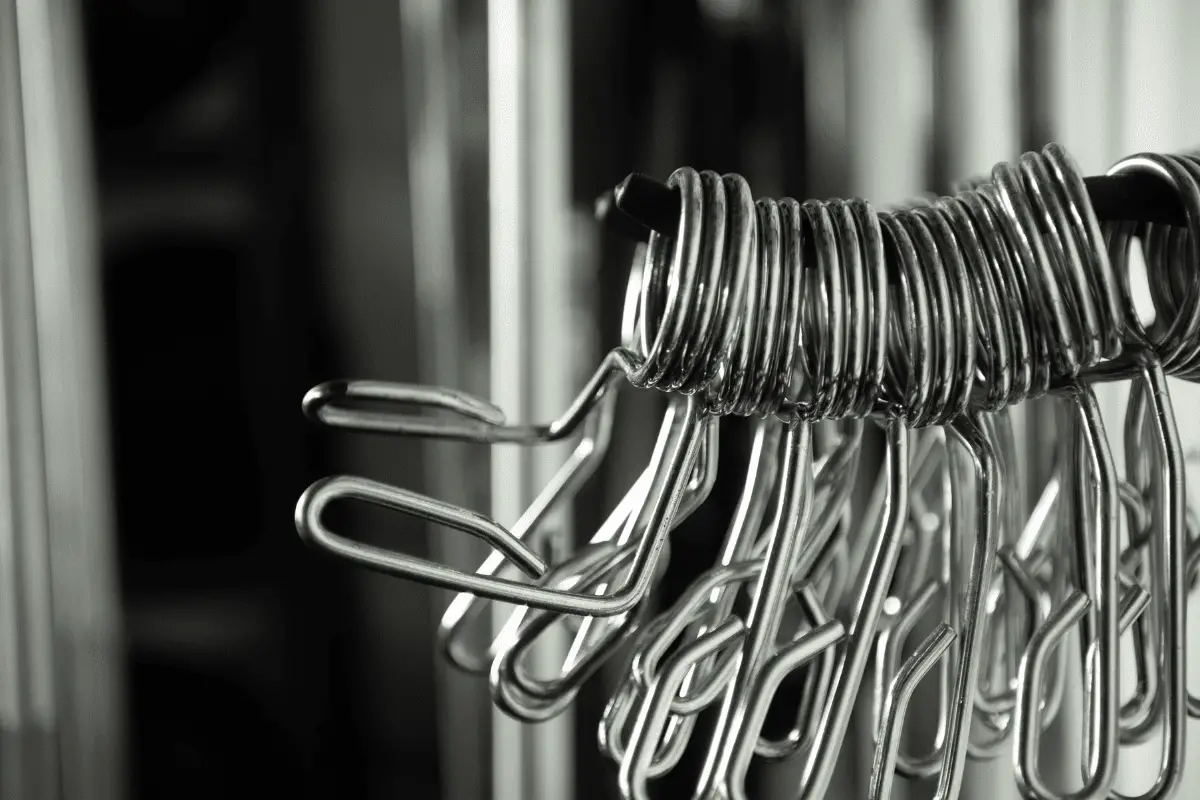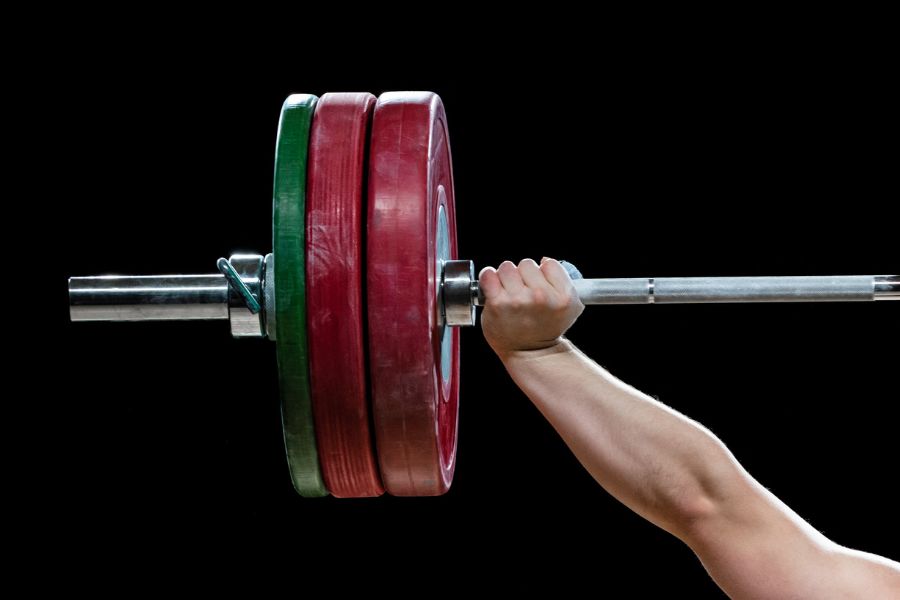Barbell collars and clips are a small and often overlooked piece of gym equipment. Often you barely know you miss it until you suddenly really wish you had a pair. These little things can keep your workouts safer and quieter.
Barbell collars and clips keep the weight plates secured on the barbell sleeves. They should be used on most lifts, especially heavy and explosive ones. When bench pressing, it’s better to leave the collars off so you can get out from under the bar more easily.
Let’s dive into why and when you (don’t) need clips. We’ll also go into what types of barbell collars there are and which type is the best for a home or garage gym.
Contents
What Are Barbell Collars & Clips?
Barbell collars and clips are crucial yet often overlooked accessories designed to keep the weight plates on the sleeves of a barbell.
Barbell clips and collars prevent weight plates from shifting or sliding during lifting by clamping down on the sleeve, giving the plates nowhere to go.
They keep your workouts, equipment, and you safe if used correctly (more on that later).
They come in different shapes and forms but the main purpose of barbell clips stays the same; keep the plates on the barbell.
Why Use Barbell Clips?
Safety
Using barbell clips reduces the risk of accidents and injuries. Unsecured weights can lead to imbalanced lifting, causing the bar to tilt or shift unexpectedly. Barbell clips keep the weights in place, preventing potential mishaps.
Especially on explosive lifts and lifts that are dropped, this can happen. Another way plates can shift is if you lean a little bit to one side. Often that means you’re failing or close to failing a repetition so plates sliding off is the last thing you want to worry about.
If it’s bad enough that a plate slides off, you suddenly change the balance of the bar. That means the bar whips around like a catapult and can actually do quite a bit of damage to both people and the gym. I’ve had this happen personally. Luckily nobody was hurt but it did leave a nice dent in a wall…
Plates falling off the bar are also plain dangerous. Dropping a 45-pound plate on your foot or other body part won’t be without consequences.
You can find the 3 best barbell clips and collars in this article.
Bar Bend
Even if you think you’re fully in control of the bar, you have to think about bar bend. This is, as the name suggests, the bending of the barbell under heavy loads. When the bar bends, the sleeves start pointing down towards the floor. That creates a nice slide for the plates to start shifting and worse.
Controlled Movements
When you’re focused on proper form and technique, the last thing you want is the weights moving unpredictably. Barbell clips ensure that your lifts remain controlled and aligned with your intended movement pattern.
Especially on explosive lifts the plates can shift if it’s not perfectly balanced.
Overhead Lifts
During exercises like overhead presses, snatches, and jerks, the barbell is positioned above your head. Barbell clips provide added security, preventing weights from slipping off and falling, which could lead to serious injuries.
Reduced Noise
Barbell clips minimize the noise produced by plates clanging against each other or the bar during drops or transitions. This is especially beneficial in shared gym spaces or noise-sensitive environments.
With bumper and rubber-encased plates, this is not going to make a huge difference but on bare metal plates, it can reduce noise massively.
Confidence
Knowing that the weights are securely fastened with barbell clips allows you to focus entirely on your workout without distractions or concerns about the equipment.
When You Need Barbell Clips
You don’t always need to use clips but in many situations, it’s safer. Here are some situations where you absolutely need clips or collars on your barbell.
Heavy Loads
When working with heavy weights, especially near your maximum capacity, barbell clips are essential. That’s because under heavy loads you’re the most likely to fail a rep or become a little uneven.
Heavier loads also increase bar bend which means the plates can start sliding without you even moving.
Explosive movements
During explosive movements barbell clips are crucial. During explosive movements, the bar starts and stops quickly, giving the plates a chance to ‘jump’ a little on the sleeve.
This can happen to a lesser degree on more controlled lifts so it’s often not as big a problem but clips will still help there.
Overhead Lifts
On any lift where the barbell goes above your head, you don’t want to take any risks. A plate falling off from that height is very dangerous and you want to prevent that at all costs.
On those lifts it’s relatively easy to throw the bar off so you won’t get stuck under it. And if you have to get out from under the barbell, you don’t want the weight to get off the bar. One heavy object flying around is dangerous enough.
New Lifters
If you’re new to weightlifting, always use clips or collars. As a new lifter, you don’t really know where your limits are and how your body reacts when you hit them. Often you fail ‘asymmetrically’ with one side of the body going down faster than the other. That tilts the barbell to one side, sliding off the plates.
New lifters also have less developed stabilizer muscles so when things start going sideways, they are less capable of correcting it.
When You Don’t Need Barbell Collars
While it’s a great idea to use them in many cases, there are also quite a few situations where they’re not really necessary or where they actually can be less safe.
Here are some of those situations;
Understanding Different Barbell Collar Types
Barbell collars come in various types, each serving the same fundamental purpose of securing plates on the bar. However, their use cases are a bit different.
Spring Clips

These are the most common type you’ll come across. They consist of a round spring that slides onto the barbell sleeves. You release the spring by squeezing the handles, and when you let go, it tightens.
While they’re affordable and straightforward, the clamping force is not always consistent, and they tend to wear out pretty quickly. You also need a decent amount of grip strength to use them. Usually, that’s not a problem when you’re fresh but they’re a pain after a hard set of deadlifts.
Quick Release Collars

While bulkier and heavier, quick-release collars are easier to use. Spring clip collars can be tough to squeeze if you don’t have strong grip strength. Quick-release collars are simpler to put on the bar and lock in place – just flip the lever, and you’re done, very little grip strength is required.
Quick Release collars are much easier to use than clips and they hold more weight. They’re a significant upgrade but they do cost more.
Screw Collars
There are two variations of screw collars.
- One type screws onto the threaded ends of a bar. Bars with threaded ends often include a set of these collars. On a regular barbell, you can’t use these.
- The other type involves a tube with a screw perpendicular to the bar sleeve. Tightening the screw secures it by pushing a little pin against the bar.
The second type is usually a decent choice for Olympic barbells. They’re not too hard to use although not quite as easy as quick-release ones. They can hold a good amount of weight but it depends on how much you tighten them so it’s not consistent. Screw collars are often pretty affordable though.
Competition Collars

Competition collars are certified for official weightlifting competitions, with standards set by the International Weightlifting Federation (IWF). These collars must meet specific criteria:
- Weight of 2.5 kg per side with a maximum tolerance of +10 grams
- Made from chromed steel
- Hole diameter of 50 mm
While there isn’t a strict rule defining the collar type, most competition collars are some kind of quick-release in practice. This ensures quick weight changes during competitions.
Which Type of Barbell Clip is Best For a Home Gym?
The quick-release type collar is the best for home or garage gyms. They are the safest because they hold the most weight and are the easiest to use.
Spring clips are just a pain to use and because of that, you’ll likely often just leave them off even when you really should use them. On top of that, most of them don’t hold all that much weight.
Screw collars are generally cheaper than quick-release ones but they’re simply not as good. They’re less easy to use and don’t hold as much weight but they’re cheaper so they are a good second choice.
Competition collars are completely unnecessary for a home gym.
Considerations When Choosing Collars and Clips
| Consideration | Key Points |
|---|---|
| Security and Stability | Choose options with good clamping force to prevent weights from shifting during lifts. |
| Ease of Use | Opt for collars or clips that attach and detach easily. Quick-release collars are best. |
| Barbell Compatibility | Ensure the collars or clips fit the diameter of your barbell sleeves. Most barbell sleeves are 50 mm in diameter as are most collars but 25 mm sleeves and collars exist. |
| Durability and Material | Select sturdy materials like steel or high-quality plastic for long-lasting performance. Metal is better but more expensive. |
| Gym Noise | Some collars reduce noise during drops; consider this for shared or noise-sensitive spaces. |
| Budget | Balance your budget with desired quality and features of collars or clips. |
| Brand Reputation | Choose options from reputable brands known for quality gym equipment. |
| Special Features | Check for extras like rubberized lining or corrosion-resistant coatings. |

